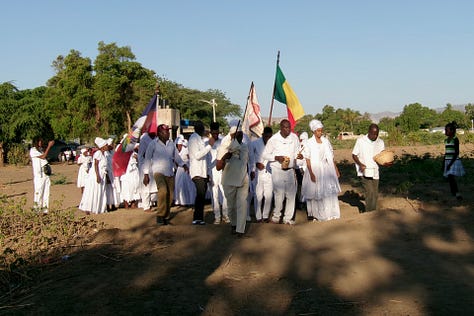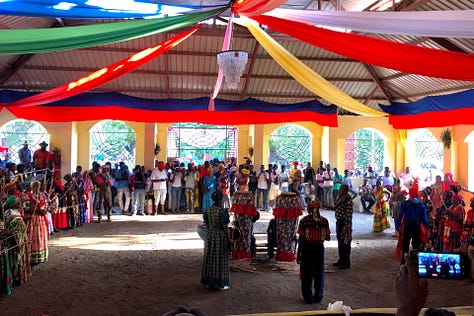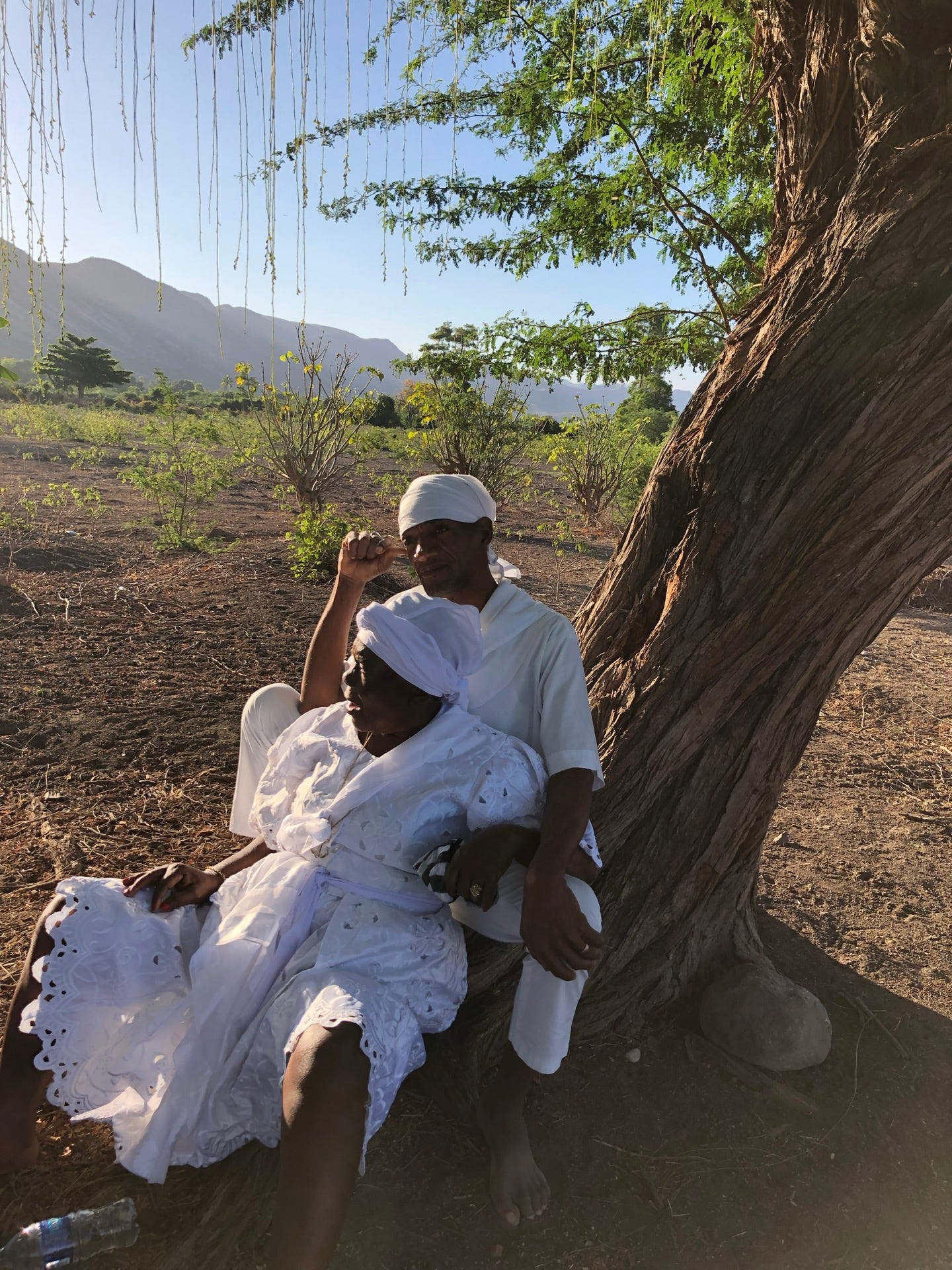#38 - Roots, Vodou and Revolution at Lakou Souvnans
To the rhythm of the ancestors in Lakou Souvnans, Wood Terib's face-off, the police resist despite everything on the Champs-de-Mars, tensions rise in La Saline and an armed base in Grand Cimetière
Lakou Souvnans was celebrated in style earlier this month, despite a noticeable drop in tourist numbers this year. Consisting of a series of dances, songs, processions and offerings, the annual festival at this famous Vodou shrine provided an opportunity for hounsi [practitioners] to reconnect with their ancestors and call for the return of peace to Haiti.
This and more in HAITI WEEKLY #38 by DÈYÈ MÒN ENFO, a collective of journalists and media professionals based in Haiti.
Editor’s note: For our first anniversary, the HAITI WEEKLY/HAÏTI MAGAZINE team has prepared a special issue on the Lakou Souvnans celebrations in Gonaïves, one year after our issue on rara celebrations in the South-East, followed by those in Grand'Anse. Enjoy your reading!
Etienne Côté-Paluck
Summary #38
The Rhythm of the Ancestors: Hopes of Bountiful Harvests and Peace in Lakou Souvnans
Videoclip of the Week: Angajman by Wood Terib
Champs-de-Mars: Police Resist in Spite of Everything
Rising Tension in La Saline
Port-au-Prince's Grand Cimetière Transformed into an Armed Base
Press Reviews of the Week
The Rhythm of the Ancestors: Hopes of Bountiful Harvests and Peace in Lakou Souvnans

For five days in early April, the drums resounded at Lakou Souvnans, on the outskirts of Gonaïves. This temple, founded in 1815, is one of the most important in the Haitian Vodou tradition. Tributes were paid and requests were made to the numerous lwa, the spirits of the ancestors who govern life according to this religion at the foundation of the Haitian nation.
Each day was punctuated by different rituals and dances dedicated to different lwa and their families. The local initiates are divided into two groups: the Grenadiers and the Hunters. These groups alternated or came together to maintain an almost continuous flow of processions and dances from morning to evening.
The public was invited to participate in the celebrations, but blockades around the capital and the disruption of Port-au-Prince’s international airport reduced attendance.
The celebrations were preceded by rara bands on Good Friday in the Catholic calendar. On Saturday, the ceremony began with a prayer among the initiates, followed by dancing and singing with the public in the peristyle (temple). Sunday was marked by offerings of all kinds and processions through several areas of Lakou Souvnans, each dedicated to a different lwa. First, chickens and sheep were sacrified under a tree dedicated to Ayizan. For the Ogou lwa, the procession went around a large tamarind tree with wooden machetes in hand, symbolizing the Haitian revolution, and an ox was sacrificed.



As Sunday afternoon progressed, the white garments gradually gave way to colorful outfits. The evening ended in the peristyle with singing and dancing in the presence of the temple dignitaries: the Empress, the Emperor and the First Larenn (in charge of singing).
On Monday, practitioners left Lakou Souvnans early in the morning for a procession to the nearby mapou trees, accompanied by drummers, to pay homage to the lwa Papa Lisa. During the day, a tribute was also paid to the lwa Agwe, protector of fishermen and sea travelers, evoking the symbolic return to Africa.








During this procession, the drummers led the group. They carried a bench and periodically sat on it to mark the rhythm. When the group of dignitaries and hounsi joined them, the musicians stopped playing and moved their bench a few feet away. Meanwhile, the crowd continued to sing in place. Then the drummers would pick up the rhythm and the group would march back to join the drummers at their new location.
Several rituals and prayers took place around a large mapou. During the ceremonies, the Empress of Lakou Souvnans gave a speech asking the lwa to bring peace to Haiti and enough rain to ensure a bountiful harvest.
As the afternoon wore on, white garments once again gave way to colorful outfits, in a salute to renewal.



On Tuesday, two large drums were placed in the center of the peristyle, to an almost warlike rhythm, representing the Asòtò lwa. This lwa allows communication with other lwa and is also strongly associated with the Haitian revolution. At the end of the day, the drums were carefully stored in their home, a small house near the peristyle, where they will remain until next year. Soon after, the festivities resumed and continued well into the night.
Wednesday, April 3, was dedicated to the children, and on Thursday the community celebrated the success of the week. A cake was shared that day, followed by a ritual bath and closing ceremonies the next day.
Music Video of the Week
Angajman - Wood Terrib
In Angajman, rapper (and singer) Wood Terrib raises an important ethical issue in Haiti, where both police officers and members of armed criminal groups come from working-class backgrounds. At the center of this confrontation, a young man with a gun justifies his choice: he feels obliged, out of duty to his country, to defend his family and his threatened neighborhood. "I can't run away from my enemies," he says. "I keep my weapons to fight, even though this is not the life I would have chosen. [...] The system makes society see me as a bandit. I have so many enemies that I can't afford to slow down. [...] When you're a gangster, you know your days are numbered."
The story continues with the words of a police officer: "The police gave me this mission," he explains. "My family is in constant fear, but I took an oath to protect and serve. I can't run away from bandits. My only regret is that the state probably won't support my family if I were to die in the line of duty."
The policeman then repeats the famous refrain from a Woody Terrib song released over a year ago: "Tell my family not to cry if I die, with my gun I will continue to protect and serve my country."
The young gunman adds to the same tune: "With my gun, I'll protect my neighborhood to survive."
Champs-de-Mars: Police Resist in Spite of Everything

While most of downtown Port-au-Prince remains under the control of armed groups, the Champs-de-Mars continues to be a bastion of resistance. The three main axes leading into the Champs-de-Mars from the south and southeast - Lalue (John Brown), Turgeau (Jean-Paul-II), and Bois-Verna - now serve as buffer zones.



For the past month, several armed criminal groups have been attempting to symbolically seize the grounds of the presidential palace, also known as the National Palace. However, this is a complex undertaking. The Champs-de-Mars is home to five major public security offices and specialized teams: the National Palace police unit, the Port-au-Prince main Police Station, the Departmental Directorate of the National Police, as well as the headquarters of the army and the Departmental Unit for Maintaining Order (UDMO, police).

In recent weeks, most police officers in the greater metropolitan area have retreated to their respective bases, which they defend against various attacks. This includes the recent incidents in Clercine, where the Brigade d'intervention motorisée (BIM, police) and the Clercine police station are located.
The members of the new Presidential Council, appointed by official decree this week, also hope to be sworn in in the coming days at the site of the National Palace on the Champs-de-Mars. Will they succeed without the ceremony ending in panic?

In Port-au-Prince, gunfire was also heard in the Champs-de-Mars on Monday during one of these attacks. Since then, the situation seems to have calmed down somewhat, although sporadic gunfire continues. Numerous gunshots were heard again last Sunday. A kidnapping was also reported Saturday on Rue 4 in Turgeau, although the number of kidnappings in the capital has decreased significantly over the past month and a half.
Throughout the city, schools are still closed, as are most offices. Nearly 100,000 people are believed to have left the capital since new clashes broke out in early March.

Tension Rises at La Saline

La Saline, a strategic district of Port-au-Prince, has become a major problem in recent months. It is usually home to the country's largest public market, an important source of income for armed groups. Its central location, between the north and south of the capital and opposite the large commercial port downtown, makes it a strategic area for various lucrative activities, such as truck theft and right of way extortion.
Clashes between two rival factions resumed this week. The local armed group, which regained control of the area a few months ago, continues to dominate, with the exception of the Lycée La Saline. This school, perched high above the other buildings in the district, offers a view that allows it to monitor the comings and goings in the neighborhood and along the main Harry-Truman boulevard, where the port is located.
Port-au-Prince's Grand Cimetière Transformed into an Armed Base

The entrance to Port-au-Prince's Grand Cimetière now serves as a base for armed groups, who control comings and goings on the street and at the Portail Léogane bus station, now devoid of its buses. A member of DÈYÈ MÒN ENFO, who lives nearby, was recently forced to temporarily relocate in order to avoid passing through the area too often. Since the attack on the Portail Leogane sub-station on February 29, the area has become a battlefield (or var in Creole) between the police and armed groups.
In addition, on the outskirts of the city, in the sector of Lambi (Gressier), a new toll station was opened for buses and trucks still trying to reach the south of the country. This brings to five the number of tollbooths under armed control on National Road #2, and according to the latest report by the National Human Rights Network (RNDDH), there are at least 13 tollbooths of this type throughout the region.
New collaboration from the DÈYÈ MÒN ENFO team with the publication Narratively:
Goodbye, Joe
It was with deep sadness that we learned of the passing of Ernst "Joe" Michel, a dear colleague and friend to many of our team members at DÈYÈ MÒN ENFO. Joe passed away due to complications from a medical procedure. We will always remember his generous spirit and deep love, as well as the warm welcome of his peristyle. Our heartfelt thoughts go out to his wife and children, and to all of his family and friends, from Cité-Soleil to La Saline and beyond.
DÈYÈ MÒN ENFO’s team
Photojournalists: Francillon Laguerre, Sonson Thelusma, Andoo Lafond, Milot Andris, Patrick Payin
Editorial board: Etienne Côté-Paluck, Jean Elie Fortiné, Jean-Paul Saint-Fleur
Interns: Wilky Andris, Donley Jean Simon
Special collaboration: Françoise Ponticq, Stéphanie Tourillon-Gingras, Clarens Siffroy, Mateo Fortin Lubin
Media partners: Centre à la Une, J-COM, Nord-Est Info
Institutional partners: Kay Fanm, Mouka.ht
Special thanks to the Fonds québécois pour le journalisme international (FQJI) for its support.
How Does Your Contribution Help?
Your monthly support helps to finance the production and pay the salaries of the DÈYÈ MÒN ENFO staff in the communities of Cité-Soleil, Port-au-Prince and Cayes-Jacmel. In addition, donations are regularly distributed for medical expenses, school fees and other emergencies in these communities.
Press Reviews of the Week
Press Review - Gender and Women Rights
presented by KAY FANM
Football : Fin de règne pour le Dr Jean-Bart à la tête de la Fédération haïtienne de football - Le Nouvelliste
Aucune explication mais tout le blâme : De jeunes mères plaident en faveur de l’éducation sexuelle en Haïti - Le National
Mobilisation des femmes du Limbé pour dénoncer la discrimination, la violence et l'exclusion - Le Nouvelliste
Sud-Est: des organisations de femmes réfléchissent sur la situation des femmes face à la crise - Le Nouvelliste
Silence, on hurle ! – La loi de ma bouche
Dossier Viol-RD: la mineure haïtienne va être entendue par la justice - Loop Haiti
Press Review - Culture and Heritage
iciHaïti - Montréal, Festival Cinéma : Le documentaire haïtien «1964 : Simityè kamoken» à l’honneur - iciHaïti
2223 Records : une maison de disques qui vise à encadrer les jeunes talents en Haïti - Le National
Une librairie sociale offre des livres à très bas prix à Pétion-Ville - Ayibopost
iciHaïti - Culture : Le Centre d’Art fait l’acquisition de «Guede Papillon» de Dubréus Lhérisson - iciHaiti
Sud-Est : Marigot a accueilli la 99ième édition de Livres en liberté - Le Nouvelliste
Clôture de la saison de Rara 2024 à Léogâne sur fond de crise - Le National
FOKAL rend hommage à Maryse Condé - Fondation connaissance et liberté
Dug-G sort son nouveau projet, « The DugFather » . Le Nouvelliste
Keep reading with a 7-day free trial
Subscribe to HAITI WEEKLY by DÈYÈ MÒN ENFO to keep reading this post and get 7 days of free access to the full post archives.

















